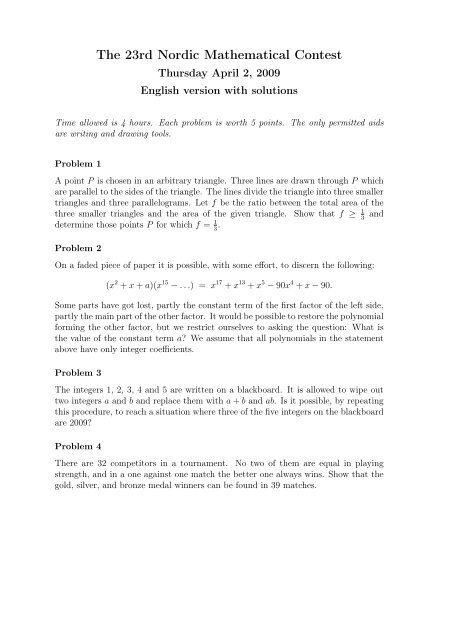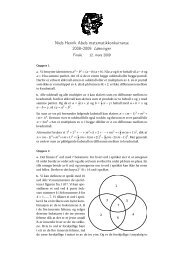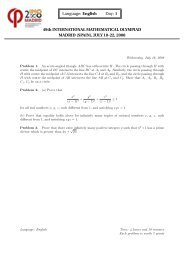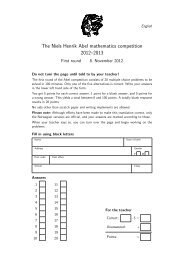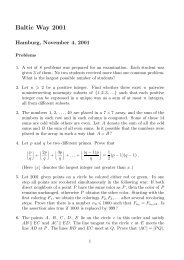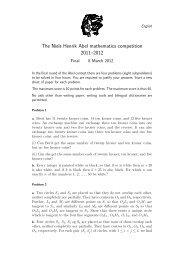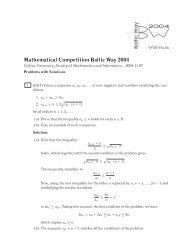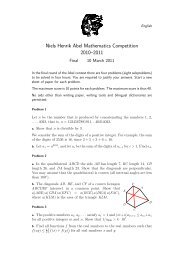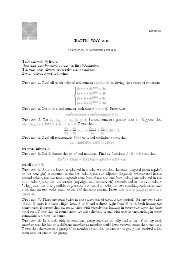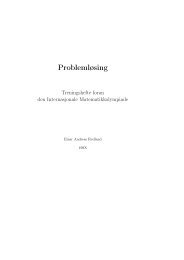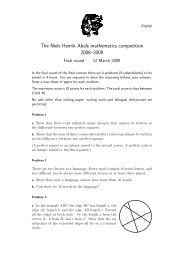The 23rd Nordic Mathematical Contest - Georg Mohr-Konkurrencen
The 23rd Nordic Mathematical Contest - Georg Mohr-Konkurrencen
The 23rd Nordic Mathematical Contest - Georg Mohr-Konkurrencen
- No tags were found...
Create successful ePaper yourself
Turn your PDF publications into a flip-book with our unique Google optimized e-Paper software.
<strong>The</strong> <strong>23rd</strong> <strong>Nordic</strong> <strong>Mathematical</strong> <strong>Contest</strong>Thursday April 2, 2009English version with solutionsTime allowed is 4 hours. Each problem is worth 5 points. <strong>The</strong> only permitted aidsare writing and drawing tools.Problem 1A point P is chosen in an arbitrary triangle. Three lines are drawn through P whichare parallel to the sides of the triangle. <strong>The</strong> lines divide the triangle into three smallertriangles and three parallelograms. Let f be the ratio between the total area of thethree smaller triangles and the area of the given triangle. Show that f ≥ 1 3 anddetermine those points P for which f = 1 3 .Problem 2On a faded piece of paper it is possible, with some effort, to discern the following:(x 2 + x + a)(x 15 − . . .) = x 17 + x 13 + x 5 − 90x 4 + x − 90.Some parts have got lost, partly the constant term of the first factor of the left side,partly the main part of the other factor. It would be possible to restore the polynomialforming the other factor, but we restrict ourselves to asking the question: What isthe value of the constant term a? We assume that all polynomials in the statementabove have only integer coefficients.Problem 3<strong>The</strong> integers 1, 2, 3, 4 and 5 are written on a blackboard. It is allowed to wipe outtwo integers a and b and replace them with a + b and ab. Is it possible, by repeatingthis procedure, to reach a situation where three of the five integers on the blackboardare 2009?Problem 4<strong>The</strong>re are 32 competitors in a tournament. No two of them are equal in playingstrength, and in a one against one match the better one always wins. Show that thegold, silver, and bronze medal winners can be found in 39 matches.
Solution 1Because the sides are parallel, all the threesmaller triangles are similar to the giventriangle. Let h be the length of a heightin the given triangle and g be the lengthof the belonging base. <strong>The</strong> correspondingnumbers in the three smaller triangles areh i and g i for i = 1, 2, 3. Because of thesimilarity there exist a numberh 1P h 3•g 1g 2g 3h 2k = h g = h 1g 1= h 2g 2= h 3g 3.Also it is easily seen that g = g 1 + g 2 + g 3 and h = h 1 + h 2 + h 3 . We havef ≥ 1 3 ⇔ 1 2 hg ≤ 3 · 12 (h 1g 1 + h 2 g 2 + h 3 g 3 )⇔ (h 1 + h 2 + h 3 )(g 1 + g 2 + g 3 ) ≤ 3(h 1 g 1 + h 2 g 2 + h 3 g 3 )<strong>The</strong> last inequality is Chebyshev’s inequality (because h i ≤ h j ⇔ g i ≤ g j ) andequality holds if and only if h i = 1h and g 3 i = 1 g with i = 1, 2, 3.3Without using Chebyshev’s inequality we could proceed in this way:(h 1 + h 2 + h 3 )(g 1 + g 2 + g 3 ) ≤ 3(h 1 g 1 + h 2 g 2 + h 3 g 3 )<strong>The</strong> conclusion is as before.⇔ (kg 1 + kg 2 + kg 3 )(g 1 + g 2 + g 3 ) ≤ 3(kg 2 1 + kg 2 2 + kg 2 3)⇔ 2(g 2 1 + g 2 2 + g 2 3) − 2(g 1 g 2 + g 2 g 3 + g 3 g 1 ) ≥ 0⇔ (g 1 − g 2 ) 2 + (g 2 − g 3 ) 2 + (g 1 − g 3 ) 2 ≥ 0Let f = 1 3 . Let M be the midpoint of the base corresponding to g 1 in the smallertriangle. Since g 2 = g 3 we also have that M is the midpoint of the base correspondingto g in the given triangle. A multiplication by a factor three from the point M carriesthe smaller triangle into the given triangle (since the two triangles are similar andbase g 1 carries to the base g). Hence P M is a median in the given triangle and sinceP is carried into a vertex in the given triangle by the multiplication of three from M,we conclude that P is the centroid of the given triangle.Alternative: It is possible to arrive at the inequality just by considering ratios: Letx 1 , x 2 , x 3 , and x be the lengths of parallel sides of the three small triangles and thegiven triangle. <strong>The</strong>n it is easy to see that x = x 1 + x 2 + x 3 . And because the trianglesare all similar, the ratio of the area of a small triangle to the area of given triangle is(x i /x) 2 , for i = 1, 2, 3. So( x1) 2 ( x2) 2 ( x3) 2 x 2f = + + =1 + x 2 2 + x 2 3x x x (x 1 + x 2 + x 3 ) ≥ 1 2 3where the inequality follows from the relation between the regular and the squaremean, or the Cauchy-Schwarz inequality, with equality when x 1 = x 2 = x 3 .
Solution 2<strong>The</strong> answer is a = 2.We denote the polynomial x 2 + x + a with P a (x), the polynomial forming the otherfactor of the left side with Q(x) and the polynomial of the right side with R(x). <strong>The</strong>polynomials are integer valued for every integer x. For x = 0 we get P a (0) = a andR(0) = −90, so a is a divisor of 90 = 2 · 3 · 3 · 5. For x = −1 we get P a (−1) = −184,so a is also a divisor of 184 = 2 · 2 · 2 · 23. <strong>The</strong> greatest common divisor is 2, so theonly possibilities for a are ±2 and ±1.If a = 1 we get for x = 1 that P 1 (1) = 3, while R(1) = 4 − 180 = −176 which cannotbe divided by 3. If a = −2 we get for x = 1 that P 2 (1) = 0, i.e. the left side is equalto 0, while the right side is equal to R(1) = −176 which is different from 0. Neithera = 1 nor a = −2 will thus work. It remains to check a = 2 and a = −1.If a = −1 we get for x = 2 that P 1 (2) = 5, so this possiblity can be eliminated byshowing that 5 does not divide R(2). As in the previous cases this can be done byevaluating R(2). To that end we observe that x 4 + 1 is a divisor of R(x), since theright side may be written as (x 4 + 1)(x 13 + x − 90). For x = 2 we get x 4 + 1 = 17 andx 13 + x − 90 = 8104, neither of which is divisible by 5.Alternatively, by Fermat’s theorem 2 4 ≡ 1 (mod 5), soR(2) = (2 4 ) 4 · 2 + (2 4 ) 3 · 2 + 2 4 · 2 + 2 − 90(2 4 + 1) ≡ 2 + 2 + 2 + 2 ≡ 3 (mod 5)so P 1 (2) = 5 does not divide R(2).Now, the only remaining possibility is that a = 2, i.e. x 2 + x + 2 is a divisor of R(x).Remark: It can be shown that Q(x) = (x 4 + 1)(x 11 − x 10 − x 9 + 3x 8 − x 7 − 5x 6 +7x 5 + 3x 4 − 17x 3 + 11x 2 + 23x − 45).Alternative: Assuming Q(x) = x 15 −. . .+dx 2 +cx+b, matching the coffecients of thelowest terms in the polynomial equation yields ab = −90 and ac+b = 1. This impliesthat a is a divisor of 90, and the possible values can then be further eliminated bychecking which divisors yield integer solutions for c in the the second equation. Thisreduces the possible values of a to 1, 2, 10, −1, −2, −9, −90. We can then eliminate10, −2, −9, −90 by considering the coefficient equation ad + c = 0 for the x 2 terms.This leaves −1, 1, and 2 as the only possiblities, but to eliminate a = ±1 with thismethod requires us to go through all the coefficient equations, because dividing by 1or −1 always yields an integer solution and we will therefore not get a contradictionuntil in the end.
Solution 3<strong>The</strong> answer is no. First notice that in each move two integers will be replaced withtwo greater integers (except in the case when the number 1 is wiped out). Notice alsothat from the start there are three odd integers. If one chooses to replace two oddintegers on the blackboard, the number of odd integers on the blackboard decreases.If one chooses to replace two integers, which are not both odd, the number of oddintegers on the blackboard is unchanged. To end up in a situation, where three ofthe integers on the blackboard are 2009, then it is not allowed in any move to replacetwo odd integers. Hence the number 2009 can only be obtained as a sum a + b.In the first move that gives 2009 on the blackboard, two integers a and b are chosensuch that a + b = 2009 and either ab > 2009 or ab = 2008. In the case ab = 2008, oneof the two chosen numbers is equal to 1, and hence 1 will no longer appear on theblackboard. In either case, the two integers a + b = 2009 and ab that appear in thecreation of the first 2009 cannot be used anymore to create new instances of 2009.<strong>The</strong> second 2009 can only be obtained by choosing c and d such that c + d = 2009and either cd > 2009 or cd = 2008, and just as before, the numbers c + d = 2009 andcd cannot be used in obtaining the last 2009. So after forming two instances of 2009,there are four integers on the blackboard that have become useless for obtaining thethird instance. Hence the last integer 2009 cannot be obtained.Solution 4We begin by determining the gold medalist using classical elimination, where weorganize 16 pairs and matches, then 8 matches of the winners, 4 matches of thewinners in the second round, then 2 semifinal matches and finally one match, making31 matches altogether.Now the second best player must have at some point lost to the best player, and asthere were 5 rounds in the elimination, there are 5 candidates for the silver medal.Let C i be the candidate who lost to the gold medalist in round i. Now let C 1 and C 2play, the winner play against C 3 , and so forth. After 4 matches we know the silvermedalist; assume this was C k .Now the third best player must have lost against the gold medalist or against C k orboth. (If the player had lost to someone else, there would be at least 3 better players).Now C k won k − 1 times in the elimination rounds, the 5 − k players C k+1 , . . . , C 5 ,and if k > 1 one player C j with j < k. So there are either (k − 1) + (5 − k) = 4 or(k − 1) + (5 − k) + 1 = 5 candidates for the third place. At most 4 matches are againneeded to determine the bronze winner.


